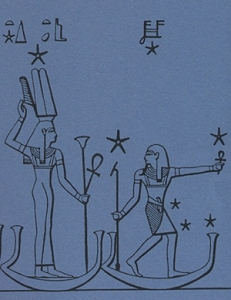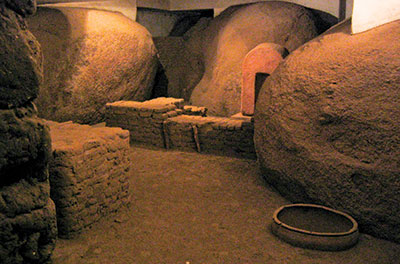For me, there are two things that make August wonderful, here in Portland, Oregon. One of them is all the produce that I can go pick on Sauvie’s Island, fresh from the farmers’ fields. (My countertops are full of peaches and tomatoes right now and peppers are on the way.) The other—and the more important for us local Isiacs—is the heliacal rising of the Star of Isis, Sirius.
While everything else starts to crisp in the late-summer heat, I am refreshed in the cool morning of Her rising power.
Now some of you may be saying, “wait, wait, I thought that happens in July.” It could. When you are able to see Her heliacal (“before the sun”) rising depends on where on this globe you are.
Here in Portland, Oregon in 2023, Sirius rises at 4:31 in the morning, Local Solar Time, on August 23rd. Further south, She rises earlier. It all depends on your latitude. You can calculate Her rising in your area with this online calculator. The calculator results are in Local Solar Time. It gives you star rise and sun rise in LST.
There is some difference between clock time and Local Solar Time. But check the time of sunrise locally and you can work backward from there. In my case, I’ll want to be at my point of observation about 5:30 in the morning, about an hour before local sunrise. And this year, for once, it may be clear enough to see Her rise.
While Isis has connections to both the sun and the moon, the heavenly body in which I most easily see Her is the star, Her star: Sirius (Sopdet in Egyptian, Sothis in Greek). And it isn’t just because of Her strong ancient connections with the Fair Star of the Waters, the Herald of the Inundation. It’s something about the way my particular spiritual “stuff” fits with Her particular Divine “stuff.” Her diamond starlight draws me, lures me, illuminates my heart and mind.
I fell in love with Her as Lady of the Star the first time I saw Sirius through a telescope. As I watched, Her brilliant star sparkled with rays of green and blue and pink and white. It was incredibly, unutterably beautiful. It was alive. And pure.
Likely, you already know why Sirius was important to the ancient Egyptians, so I won’t repeat that here. But I would like to add a few interesting bits about Sirius that you may not know about; in particular, the orientation of some Egyptian temples and shrines to Sirius at the time of their construction. For instance, the small Isis temple at Denderah and Isis’ great temple at Philae seem to have been oriented toward the rising of Sirius. Philae may even have a double stellar orientation: one axis to the rising of Sirius, one to the setting of Canopus.
Overall, Egyptian temples have a variety of orientations. A survey of temples taken between 2004 and 2008—that actually went to the temples in Egypt and measured the orientation—showed that most temples were oriented so that the main entrance faced the Nile. But not only that. It seems that the temples were also oriented toward other astronomical events, most especially the winter solstice sunrise, which of course makes very good sense as a symbol of rebirth.
Orientation to Sirius is rarer and harder to be certain of since the earth’s position in relation to the stars has shifted over the millennia.
A Horus temple, called the “Nest of Horus” on the summit of the highest peak of the Hills of Thebes, seems to have been oriented to the heliacal rising of Sirius around 3000-2000 BCE. Nearby, an inscription carved in rock during the 17th dynasty (1580-1550 BCE) records the observation of just such a rising of Sirius. This high place would have been ideal for Horus in His nest to await the coming of His mother Isis. On the other hand, the archaeoastronomers who did the survey I mentioned believe that it may also be oriented to the winter solstice sunrise, an event closely associated with Horus.

Another temple that may have a Sirius orientation is the archaic temple of the Goddess Satet on the island of Elephantine. The original temple was built amidst the great boulders on the island and really is quite simply the coolest temple ever. It seems that when it was built (around 3200 BCE) the rising of Sirius and the rising of the winter solstice sun were at the same place—so it could have been built to accommodate both important astronomical events.
After the initial study, the same team followed up with a survey (in 2008) of some temples in the Fayum that they hadn’t been able to study before as well as temples in Kush. They found generally the same results except for the Nile orientation since many of these temples were built far away from the river. They made note of a son of a Priest of Isis, Wayekiye, son of Hornakhtyotef, who was “hont-priest of Sopdet” and ”wab-priest of the five living stars” (the planets) and “chief magician of the King of Kush.” This is from an inscription on Isis’ temple at Philae dating to about 227 CE. It emphasizes the importance and sacrality of the study of celestial objects and events to the kingdom and it is quite interesting that this was the work of the Chief Magician. This study revealed that most Kushite temples and pyramids were oriented either to the winter solstice sunrise or the rise of Sirius.
Another interesting thing the study found was that by the time of the New Kingdom, in the 34 temples that were unmistakably dedicated to a Goddess—specifically Isis or a Goddess associated with Her—the most important celestial orientation point was the rising of Sirius. But, in addition to Sirius, the star Canopus was also a key orientation point. According to their data, Goddess temples in general were more frequently aligned with these very bright stars, Sirius and Canopus, while God temples were more often oriented to key solar-cycle events. Isn’t that interesting?

If you are, as I am, feeling the anticipation of Her rising later this month, you might like to do some ritual. The Opening of the Ways is always good. You could use it as an invitation to Her. Or try a simple meditation, allowing yourself to yearn for Her coming. Waiting for Her and wanting Her is sometimes a very good exercise. You might set out a vessel of water (a shiny silver one is nice) on the night of Her rising, let it be charged with that rising energy in the dawn, then use it as part of your holy water for purification. I have just such star water that I use waiting in my shrine right now.
















